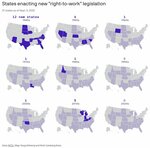

Debate has returned to ME Regional High School with the arrival of Joan McWhorter as primary coach, assisted by debate coach emeritus Tim Averill and a group of eager debaters, all ready to re-establish MERHS as one of the premier debate teams in New England.
Point, Counterpoint will be a monthly feature highlighting a current team debate topic. Sometimes controversial, these “pro” and “con” arguments follow specific rules of debate to ensure a fair and challenging competition. They do not represent the opinion of the debater. In fact, debate fosters strong civil discourse because debaters are often forced to adopt and defend views they may not agree with.
This month’s topic—right-to-work laws—is timely, as some states are revisiting the role of unions and whether they remain relevant today. Juniors Gwendolyn Berger and Stella Straub led the charge on the arguments.
The MERHS Debate Team thanks the school principal and administration for their strong support of the debate renaissance at MERHS.
The CON side of this debate argues that right-to-work laws do more good than harm. The term "right-to-work laws" refers to state laws that prohibit union security agreements between employers and labor unions which require employees who are not union members to contribute to the costs of union representation.
There are many different stances that the CON side can take on this resolution. However, the main argument that CON would be making is that right-to-work laws increase economic growth, prevent compelled speech, and hold unions accountable.
States with right-to-work laws attract businesses as right-to-work laws limit union power and by extension, union aggression. This stimulates business investment and attracts businesses to states with right-to-work laws, thus creating more jobs. Both workers and employers’ benefit from a better economy as both wages and profits increase. A market that is particularly impacted by this is the manufacturing market. “Studies have found that right-to-work laws increased manufacturing employment by approximately 30 percent” (1).
Furthermore, right-to-work laws protect against compelled speech. Compelled speech is when a group forces an individual to support a certain expression. For example, unions often take political stances and use the dues of all members, regardless of members’ views, to support certain political candidates and legislation.
Although compelled expression may be helpful when a worker’s views align with the union’s political action, there are two main deleterious issues. The first is that workers’ dues can be utilized to support political issues that they don’t agree with. The second being that unions can be corrupt and not adhere to the democratic desires of their members. Unions are still “plagued by rampant corruption, embezzlement, racketeering and influence from numerous organized crime organizations. From penny-ante theft to multi-million-dollar embezzlement schemes, labor leaders continue to violate the trust of the members they claim to represent” (2).
Although the National Labor Relations Act (NLRA) restricts unions from collecting dues for political activities if a union member chooses to opt-out, the reality is that “a McLaughlin & Associates poll indicated that 67 percent of workers were unaware of their right to withhold mandatory dues for politics” (3).
Finally, right-to-work laws hold unions accountable. Since workers can choose whether or not to join a union and whether or not to pay dues, the union has to ensure that they are truly representing and advocating for the workers. The risk that a union will be plagued by corruption is significantly diminished as members can simply leave in response and the union would lose its power and funding.
The affirmative side of this argument will focus on the negative impacts of right-to-work laws on unions, primarily in terms of decreasing both union membership and power.
Right-to-work laws undermine the goals of a union. By allowing workers to profit off of the benefits negotiated by the union, the incentive to join and pay membership dues is destroyed. Simply put, right-to-work laws hurt unions, which are crucial for protecting workers.
According to a study by the National Bureau of Economic Research (4), right-to-work laws decrease union membership rates by four percent in the first five years of adoption. Additionally, their data shows a 20 percent difference in union membership between states with and without right-to-work laws.
Union membership allows unions to have a voice; it represents the strength and size of the union’s bargaining power. Additionally, membership provides unions with the resources necessary to successfully advocate for members through funding by union dues. With a decrease in membership, unions lose funding for their operations, including the negotiation of contracts.
Unions are critical to the workplace for a number of reasons, and damaging unions will directly hurt workers.
One of the most important functions of a union is to negotiate for better wages and benefits for members. Unions have bargaining power with employers; this gives them leverage in the workplace that an individual employee would never have.
In fact, The Bureau of Labor Statistics (5) reports that non-union workers earn just 83 percent of what unionized workers earn ($975/week vs. $1,169/week).
Without the pressure of a union, employers have no incentive to raise wages for workers or promise good benefits.
They also provide a unified voice for workers to address common concerns and negotiate with employers on topics such as workplace safety.
According to the Economic Policy Institute (6), states with Right-to-Work laws show a 54% increase in workplace fatalities.
In a right-to-work environment, without a union to protect them, workers would not be as comfortable expressing their concerns for fear of being treated unfairly, leading to a more dangerous workplace and more injuries – a problem only compounded by the fact that there would be no union to guarantee solid healthcare benefits.
Right-to-work laws prioritize employers’ wages and a business’ profit over the safety and well-being of workers. Unions simply cannot protect employee’s rights effectively under these laws, meaning that the direct impact falls squarely on working-class American citizens.
Thus, we affirm; right-to-work laws do more harm than good.
Want to Read More?